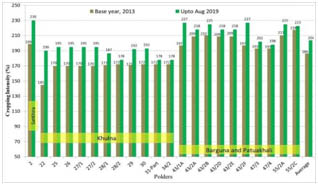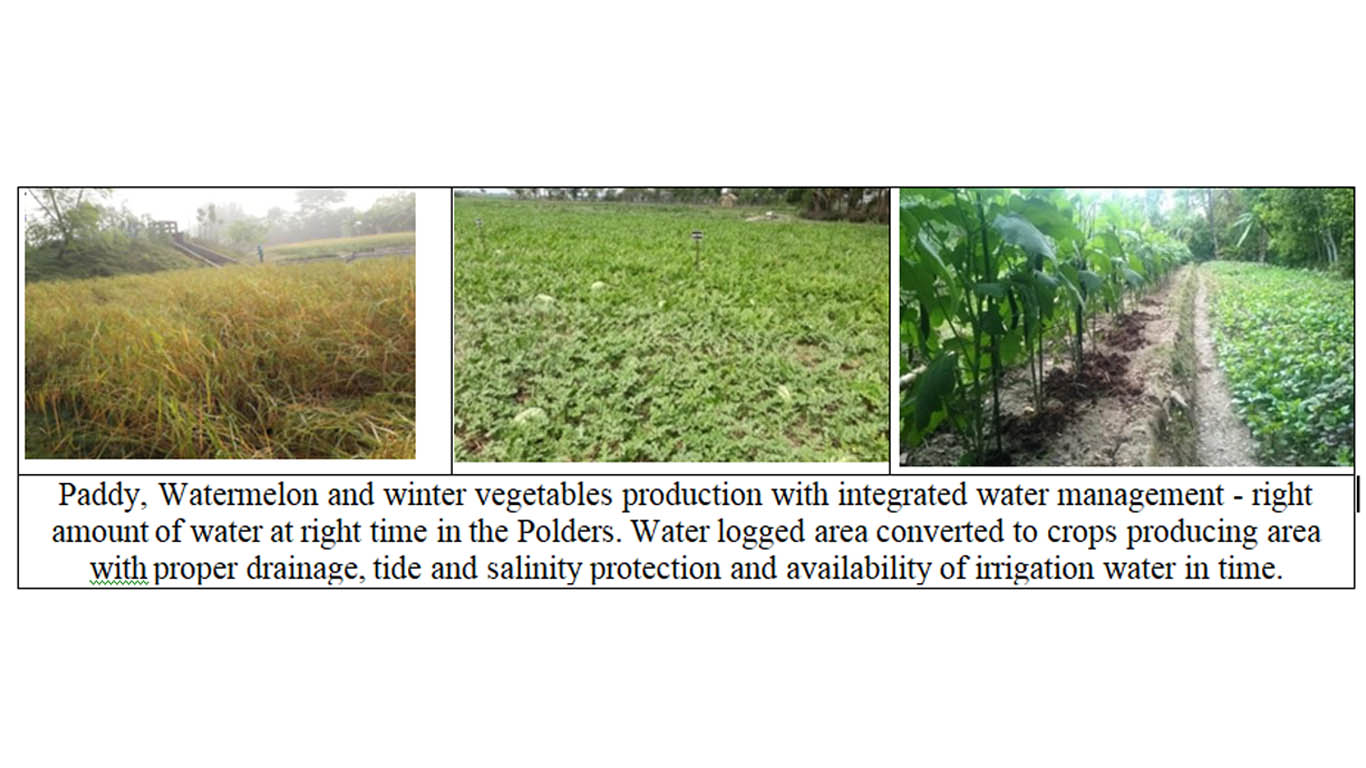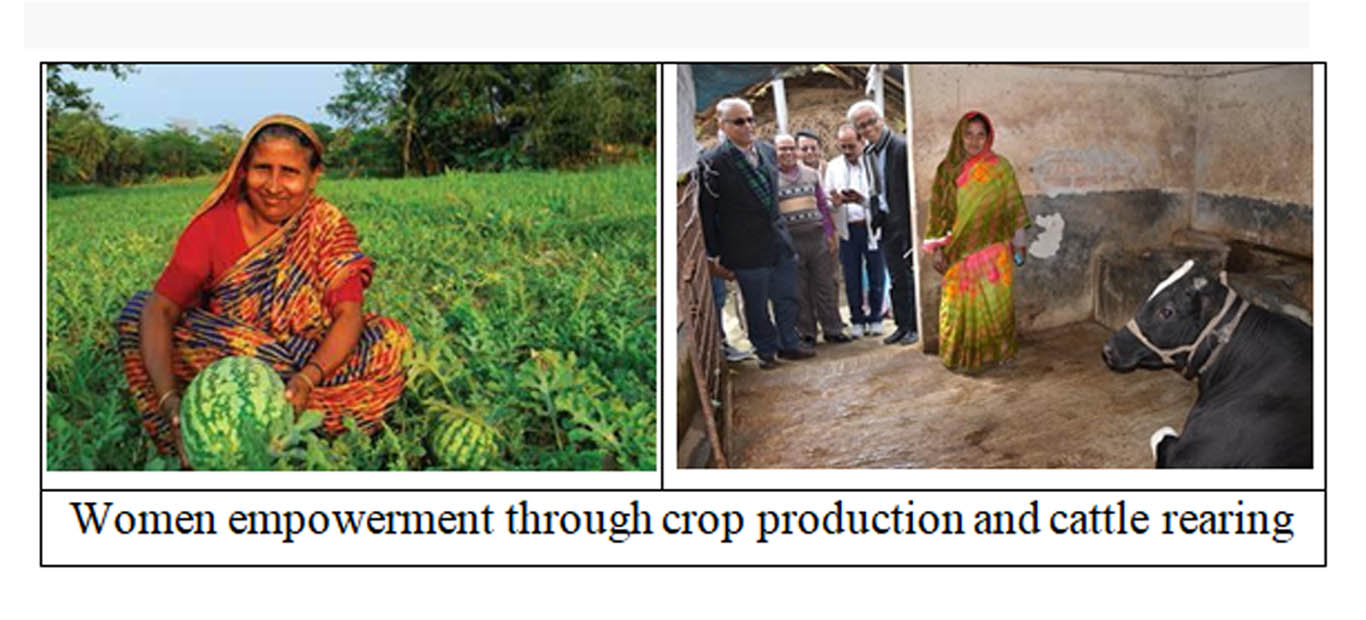Blue-Gold Program for Improvement of Water Management in Coastal Polders

Background: Geography, location and hydrology of our country having huge impact on lives and livelihood, nature, environment, agriculture, development, communication, food security, poverty reduction. Water is the key natural resources and on the other hand major source of disasters of this country. The dependency and demand of water resources is increasing day by day with population growth, more food production, urbanization, industrialization and development. Water related disaster like flood, drought, river bank erosion, waterlogging, water pollution, high tide, salinity etc imposes adverse impact on people's lives and livelihood, development, food security and poverty status in coastal area. Indiscriminate and unplanned use of water resources is one of the main reason for pollution which is extremely harmful to public health and environment. The "Blue Gold Program" an integrated program for coastal polder development is being implemented under Bangladesh Water Development Board (BWDB)-as lead agency and Department of Agricultural Extension`(DAE) with grant support from the Government of
Netherlands (GoN) and the Government of the People's Republic of Bangladesh (GoB). The GoN, long Development Partner of Bangladesh in water sector, extended technical and financial support in grant in this program.
Program Area: Total 22 numbers of polders in 14 upzilla in 4 South and South-west coastal districts (Barguna, Patuakhali, Khulna and Satkhira). Implementation period of the program is from January 2013 to December 2021.
Objective: The overall objective of the Program is to reduce poverty of about 190,000 households living in119,124 hectares (10% of total coastal polder area of Bangladesh) in 4 coastal districts by enhancing the livelihood of the rural population, through more efficient integrated water resources management and increase productivity of crops, fishery and livestock in the polders and by empowering the communities to be the driving force. The specific objectives of the Program are: (a) Sustainable development of the polders through community participation, (b) Prepare the community organizations as driving force in Polder water management, (c) Integrated water resources management in Polder area through improving natural environment with flood and salinity, reducing waterlogging, retaining rain water and ensuring availability of salt free water for household and irrigation and d) Improving income, capacity and quality of life by increasing production.
 Structural activities: To achieve the objectives, existing water management infrastructure is constructed, rehabilitated or repaired in total 22 polders selected in four districts, detailed is shown in table. These structures are needed for integrated water management in 119,224 hectares land of polders in 14 upazillas of four districts.
Structural activities: To achieve the objectives, existing water management infrastructure is constructed, rehabilitated or repaired in total 22 polders selected in four districts, detailed is shown in table. These structures are needed for integrated water management in 119,224 hectares land of polders in 14 upazillas of four districts.
With this structural activities integration of capacity enhancement of community, waterlogging has been reduced in 22 polder areas 119,224 hectares of land and availability of irrigation water has been ensured. Agricultural lands, houses, towns have been saved from the flood of salt water. An enabling environment
for agricultural production has been ensured, land and water productivity has increased, which benefiting 190,000 families in these 22 polders.

Non-structural activities: Part of integrated works, the water management organizations has been formed and trained on agriculture, vegetable cultivation, rearing of poultry and livestock, fish farming in ponds, improved water management, sanitation and health awareness etc. Under the non-structural component (4 districts, 14 upazillas) 512 Water Management Group (WMG) and 39 Water Management Association (WMA) has been formed, 1,133 Farmers Field Schools (FFS) and 190 sub- committees have formed for water management, repair and maintenance. Savings of all 512 WMGs is Tk 919.45 lakhs. Contribution by the WMG for infrastructure management, minor repairs and maintenance is Tk 71.50 lakhs which indicates the visible progress of capacity of the local organization. Local organization already planted 64400 trees (A variety of fruit and forest trees). Under the Blue- Gold program, a total of 27,325 persons have been trained in agriculture, fisheries, domestic animals husbandry, poultry, water management, etc., out of which 3,591 are men and 24,834 are women. Ponds adjacent to the homesteads and abandoned small ponds are brought under fish farming. The participation of local people is ensured in the regular operation, repair, adoption and implementation of water management infrastructure in Polder.
Water Management and Agricultural Development:Water Management and Agricultural Development:
Construction or repair of embankment, regulators-inlets- outlets, re-excavation of canals, etc. in Blue Gold Program area in polders under Blue Gold Program contributed in protecting flood, tide and salinity in the Polders, reducing waterlogging during monsoon and ensuring necessary saline free water for household and irrigation in dry season. As a result, vegetable, fruit, livestock and fish farming activities have increased. Productivity of land and water in the project area has multiplied by ensuring an agro-friendly environment
through water management. Thus the project is making a significant contribution to the food security as a result of the supportive policies and initiatives of the government along with the participation of local people. In during 2013-2017, remote sensing satellite data showed that the area under cultivation has increased due to decrease in waterlogged area in polders area under Blue Gold Program and single cropped land has been converted into double or triple cropped lands. In the adjoining polders where there is no repair or rehabilitation activity, the waterlogged area has been increasing and double or triple cropped lands have been converted into single cropped lands. Remote sensing data shows that waterlogging in the Blue Gold Program area has decreased by more than 66%. The DAE data revealed, the cropping intensity has been increased from 186.3% in 2016 to 203.9% in 2019 and with average increment of 17.6% during 2014-2019 (DAE-

2019). In these polder areas, the average yield per hectare has increased by 7.5% for Aus paddy, 8% for Aman paddy, 5.5% for Boro paddy and 26% for Mungbean (Mug dal). The selected abandoned ponds have been brought under semi-intensive fish farming with the technical assistance from Department of Fisheries. Fish production in ponds cultivated by local people has increased by 87% (almost double) (Source: Department of Fisheries-2019).
 Socio Economic Development: Regulator, outlet, inlet etc. infrastructures is being operated through local water management organizations for water management, to make the community as driving force. The improvement of water availability and land productivity became possible in Polder area through integrated efforts of the government agency, BWDB, DAE, Dept of Fisheries & Livestock and the people of that area through integrated water management, which is contributing in food security, employment generation and poverty reduction in that area. The contribution of the fisheries sector in food security and economic development is very important. The income of the people of that area has increased by about 25%. The participation of local people in small scale repairs and maintenance of water management infrastructure of 22 polders has been ensured. This will make those infrastructures and water management sustainable. The activities and supports of the DAE, Department of Fisheries and Livestock have become conducive and efficient through 512 organized and trained WMGs in 22 polders. The WMGs in the area is benefiting the farmers by coordinated of collective purchasing agricultural inputs (fertilizer, seeds, land preparation service etc.) and selling the agricultural products. With such collective buy/sell of agricultural products, local farmers of Patuahali area able to export Mungbean (Mug dal) to Japan, enable them with fair price. Ensuring 50% participation of women in training and 33% participation in WMG has created an environment conducive to women's empowerment in water management and agricultural production in that area. Overall, the income of women in the area has increased. The family nutrition and income has been increased due to increased production of crops, vegetables, fish, poultry, etc. Discussion with the WMGs revealed that, in the BGP area during 2016-2020 period, number of school going children and houses with electricity coverage have been increased.
Socio Economic Development: Regulator, outlet, inlet etc. infrastructures is being operated through local water management organizations for water management, to make the community as driving force. The improvement of water availability and land productivity became possible in Polder area through integrated efforts of the government agency, BWDB, DAE, Dept of Fisheries & Livestock and the people of that area through integrated water management, which is contributing in food security, employment generation and poverty reduction in that area. The contribution of the fisheries sector in food security and economic development is very important. The income of the people of that area has increased by about 25%. The participation of local people in small scale repairs and maintenance of water management infrastructure of 22 polders has been ensured. This will make those infrastructures and water management sustainable. The activities and supports of the DAE, Department of Fisheries and Livestock have become conducive and efficient through 512 organized and trained WMGs in 22 polders. The WMGs in the area is benefiting the farmers by coordinated of collective purchasing agricultural inputs (fertilizer, seeds, land preparation service etc.) and selling the agricultural products. With such collective buy/sell of agricultural products, local farmers of Patuahali area able to export Mungbean (Mug dal) to Japan, enable them with fair price. Ensuring 50% participation of women in training and 33% participation in WMG has created an environment conducive to women's empowerment in water management and agricultural production in that area. Overall, the income of women in the area has increased. The family nutrition and income has been increased due to increased production of crops, vegetables, fish, poultry, etc. Discussion with the WMGs revealed that, in the BGP area during 2016-2020 period, number of school going children and houses with electricity coverage have been increased.
Capacity strengthening in disaster management: Capacity has been enhanced at the community level by through of 512 WMG in 22 polders in 14 upazilas of the four coastal districts. These WMGs are active in guarding the Polder round the clock in case of cyclonic tidal surges, repairing the damages in case of emergency. In previous years, during Roanu (May 2018), Mora (May 2018), Fani (May 2019), Bulbul (November-2019) and Amphan (May 2020), except two polders in Khulna and one Polder in Patuakhali out of 22 polders in 19 numbers of polders under Blue Gold Program were protected, where water could not enter the village by breaching embankment, thus protecting the area's crops, livestock, fish, etc. from the cyclone. During Bulbul and Amphan total financial contribution from the WMGs, the local community, for emergency repair was taka 21,14,200/ in the Blue Gold Program area.
Environmental Development:
Environmental impact assessment has been carried out on the implemented Blue-Gold Program area with the aim of evaluation of environmental friendly sustainable socio-economic development. Rules and policies have been followed in environmental impact assessment.
The natural environment has improved and the biodiversity has been balanced in the Blue Gold Polder area. Balanced environment for agriculture, fisheries and aquatic life has been created in polders. In addition to the regular tides, the lives and resources inside the polder are being protected from tidal surges. The selected polders are
ensuring safe Environment for the production of agriculture, fisheries, fruits, vegetables and alleviating the suffering of the people by resisting tidal and salt water. The availability of salt-free water for canals, ponds and other reservoirs in the Poldar area during the dry season has ensured water for domestic and agricultural use and thus maintaining the balance of the natural environment.
Conclusion: Polder area has been protected flood, salinity and waterlogging in monsoon due to re- excavation of canals, repair / reconstruction of water management infrastructure and drainage of water through active participation of the people. Re-excavation multiplied the water retention capacity of the canal/khal and ensured availability of saline free water for agriculture, fisheries, animal, domestic usages during the dry season. Improve the natural environment along with increasing agricultural production through the efficient use of water by protecting the saline water, surge and tides inside the polders and conserving rainwater in excavated canals and other reservoirs. Natural resource based production, employment and development of the area has been accelerated. Improvement of the quality of life of the people in polder area has become possible due to increase in economic activities. The capacity and rights of community in water management in Polder have been established, make them driving force in the Polder. Increased availability of usable water has increased crop production and fish production in ponds. The integration of structural measures and social or non-structural measures made it possible to improve the quality of life in the area along with the development of the environment. In addition to ensuring food security in the area, the Blue Gold Program is making a significant contribution to national food security. Considering the impact of climate change, program like Blue Gold need to be expanded and extended to meet the future challenge in the Coastal area of Bangladesh.
Additional Chief Engineer, Bangladesh Water Development Board(BWDB), Dhaka. Worked for Blue Gold Program till January 2021, e-mail : amirulbd63@gmail.com
If you liked this article, then please subscribe to Bangladesh Post YouTube channel for latest news. You can also find us on Twitter and Facebook.





